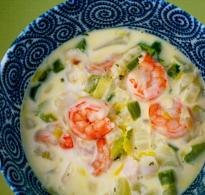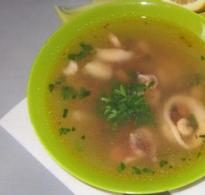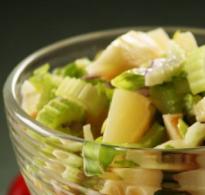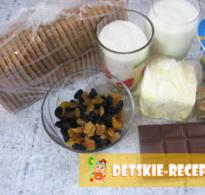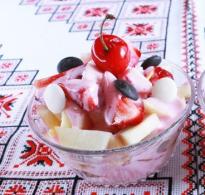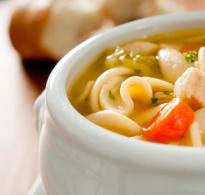What is seafood. Edible shells: clems, mussels, scallops, oysters and gastropods
Consider a list of the most interesting and delicious arthropods and mollusks. While these cute, tasty and interesting "reach" us, half of the taste is lost, so it is reasonable to talk about the true freshness of seafood only on the seashore.
Crab/Crab(English.)/Crabe(fr.)/Cangrejo de mar (Spanish.)/grancio(it.)
Where to eat: everywhere.
As is: boiled or in the form of a soufflé. Serve hot or cold. They are eaten with tongs and a two-pronged fork. The only pity is that in crab meat 15% of the total weight.

Bigorno/Bigorneau (fr.)
Where to eat: Northern France.
As is: boiled with sauce. They are served with skewers or pins, with the help of which, holding the shell in your left hand, you pull the snail out with your right.

Lobster/Homard(fr.)/Langosta(Spanish)/Aragosta(it.)
Where to eat: Italy, Spain, France, China, Japan, Indonesia, Thailand.
As is: boiled, grilled, baked or added to dishes. Handling a whole lobster with the help of special tongs, a knife and a hooked fork is an art worth learning for the sake of this delicacy.

Persebes/Percebes(Spanish)
Where to eat: Galicia and the Basque Country.
As is: boiled in its pure form, without sauces and, even more so, without a side dish.

Trumpeter/Bulot(fr.)
Where to eat: Northern France.
How to eat: bulo is cooked right in the shells, because you can’t get them raw from there. Eaten with garlic cream sauce, usually with a fork.

Tiger shrimp/Tigerprawn(English) / Ushi-ebi (Japanese) /Grassshrimp(thai)/Ghostprawn(in Hong Kong)/Udangpantjet(in Indonesia)
As it is: shrimp are boiled, grilled or deep-fried - right with the tails. Serve as an appetizer, add to salads and hot dishes. Eat with hands, forks, chopsticks.

Abalone/Awabi (Japanese)
Where is: Japan, Korea.
How to eat: the meat of this large clam is most often served on its own shell, which turns into a convenient plate.

Sea urchin / Uni (jap.) /Erizo(Spanish)/Ecino(it.)
Where to eat: Mediterranean, Japan.
As it is: in Japan, caviar of sea urchins is considered a delicacy. It is served with soy sauce, used in the preparation of sushi, and also as a component of sauces. It is eaten raw, sautéed or pickled. On the Mediterranean coast, sea urchins are cooked hot.

Shrimp/Shrimp(English)/crevette(fr.)
Where to eat: everywhere.
As it is: each nation comes up with its own recipes - from the simplest boiling in salt water to complex warm salads or frying in oil with garlic. The main thing is not to overdo it on fire. You can eat with your hands, and peeled shrimp with a fork.

Krill/Krill(English)/Okiami (Japanese)
Where is: Japan, Korea, England.
How to eat: the creatures are so small that for eating they are boiled whole, salt and spices are added and ground into a paste. Especially large ones are boiled and cleaned like shrimp. Most krill is eaten in Japan. Its extraction is quite a complicated and expensive process, so krill is more often eaten by whales than humans.

Shrimp Jumbo/jumbo(English)
Where to eat: countries of Southeast Asia.
As it is: boiled or marinated in spicy sauces with butter and fried in nets on the grill. Eat with hands or a fork.

Trepang / Hey-son (Chinese)
Where to eat: Japan, East China and Yellow Seas, south of Sakhalin and Kunashir, the Pacific coast of Japan.
How to eat: eat muscle - lean meat, rich in protein. Used fresh, dried and salted. The Chinese call it the second ginseng because of its stimulating properties.

Squid/Kalamari(Greek) /Calamari(it.)
Where to eat: Sicily, Greece.
How to eat: Freshly caught squid can be eaten raw. They are usually grilled, deep-fried, stuffed or added to salads.

Vongole/Palourde(fr.)/Vongola(it.)
Where to eat: Mediterranean.
As is: raw. In addition, clams are boiled, stewed in wine with spices or in their own juice, stewed in herbs with fragrant oil, added to pasta and soups, baked with cheese.

Mussel/Mussel(English)/Cozza(it.)/Moule(fr.)/Mejillon(Spanish)
Where there is: the Far East, Japan, Great Britain, France, Flanders and the entire Mediterranean.
How to eat: baked in shells and served hot. Mussels go well with other foods, so they are fried hot with vegetables, potatoes, spices, added to salads, paella and soups.

Oysterbelon/huitre belons (fr.)
Where to eat: Brittany.
As is: fresh with lemon, preferably in the cold season. They have a pronounced marine aftertaste and a dense meat structure.

Venerka / Umugi (jap.) /Praire(fr.)
Where is: Japan, France, countries of Southeast Asia.
As it is: with sour and spicy sauces, in seafood cocktails and in salads.

Oyster blanville/Huitreblanville(fr.)
Where to eat: Normandy.
As is: like other oysters - fresh with lemon. Due to a special cultivation method, they are enriched with trace elements and fatty acids.

Octopus/Octopus(English)/Polpo(it.)/pulpo(Spanish)/Chtapodi(Greek)
Where to eat: Crete, Galicia, Mauritius, Italy.
As it is: in raw, boiled, stewed and fried forms. In the Mediterranean, it is soaked in wine vinegar. Small and medium ones are cooked whole, and steaks are made from large ones.
For a coastal dweller, edible shells are as familiar as the sound of the surf. However, in the depths of the continent, this is an undoubted luxury that requires both money and a worthy occasion. And the season of most edible shells falls precisely on the cold season. But shells can poison you, and seriously. Therefore, you need to be able to choose them and prepare them correctly, which requires both skills and some artistry.
Clems
Chefs and seafood vendors call shells " terminals”, but this name is not applied to all shells, but only to their two groups - sandy and hard shells.
The shells of the first - actually sand shells, razevnitsy And marine cuttings- do not close completely, and any such shell is full of sand. It must be removed. The best way: shells should be dipped in a bucket of salt water - the ratio of salt to water is 1:10 - and placed in the refrigerator overnight. If you don't have that much free time, put them in a bowl and rinse with water until no more sand appears at the bottom of the bowl. As a last resort, if you did not remove the sand from the shells before cooking, you can do it after. Cut the meat out of them and lower it into the broth - the sand will sink to the bottom of the pan in a few minutes.
Hard shells come in different sizes and colors, but are conventionally divided into three types. The first is the smallest, known as " juvenile hard shell”, a maximum of 5 cm in diameter; the second - actually hard shells, from 5 to 8 cm, and the last - the so-called soup shells, sometimes reaching up to the size of a large computer mouse. You don't need to wash them at all. The shells of all these mollusks open when heated, but they can also be opened with a knife by inserting a blade between the valves opposite the lock, and then passing it between the valves. It's harder to do than to tell, but with time comes skill.
As for the definition of the quality of both hard and sand shells, it is standard. The only rule: the smaller the shells, the tastier and more aromatic. But the larger, the less trouble and more meat.

mussels
Before you start cooking, you need to sort out the mussels, and the main thing at the same time is not to be greedy. If the sink is slightly open, tap on it with your finger - it should close slowly but tightly; if it doesn't close, throw it away. Also, get rid of mussels with broken shells, as well as those that are too light or heavy - they are light because they are empty, and heavy because they have silt.
Preparing mussels for cooking is easy. If they have a "beard", scrape it off with a knife (or just tear it off with your fingers). Then put the mussels in a saucepan and put for 1 hour under a stream of cold water. And cook. Yes, by the way, throw away the mussels that did not open during the heat treatment process.

scallops
Scallops are small (about 7 cm across), large, known as Saint Jacques(15 cm) and ... marine, which are even larger. You should be aware that sometimes they are treated with a solution sodium tripolyphosphate, and their weight increases by 25%. This is not harmful to human health, but when heated, such a scallop begins to release absorbed water - the same 25%. A distinctive feature of tripolyphosphate victims is the bright white color of the meat (naturally, scallops have a slightly creamy hue, in some cases intensifying to pale orange or pale pink). Imported scallops that have escaped such a chemical attack must be marked as dry scallops.
By the way, scallops are the very rare case when freezing does not make the product worse. The only downside to frozen scallops is that you only get the actual meat at your disposal. Meanwhile, scallops also have caviar bags- also very tasty and hellishly healthy. Therefore, if there is a case, be sure to buy a scallop in the sink. They open with little effort with a small knife. You just need to carefully scrape the meat from the lower half of the shell, cut off the side of the white lock muscle and remove the dark insides.

oysters
The world of oysters is described in the most thorough manner; unfortunately, these descriptions, apart from practice, are unbearably boring, and practice is complicated. Therefore, let's understand at least the basics, so as not to spoil our holiday.
Firstly, a live oyster served to the table should show muscle activity, but the nature of this activity may be different. If the oyster has been transported as it should, it wakes up slowly, and if you touch the edge of its mantle, it moves it away with dignity. But if an oyster twitches like a scalded one, it means that during transportation it was shaken, woke up, heated or frozen - and in this regard, there is nothing to say about the true taste. Do not eat her, take pity - she has suffered so much, and you will not be happy either.
It is equally important to understand what all sorts of beautiful words and numbers that you read on the menu mean, since the state of your wallet directly depends on this. Let's say "special de clair" No. 3 or No. 5 ...
Let's start with rooms. Oysters are numbered according to their weight: the smallest ones are numbered #5, and the largest ones are numbered 0 and 00. Keep in mind that these numbers have different values for different varieties of oysters, but #3 will always be smaller than #1.
What means " clerk "? This is such a pool connected to the sea by a narrow canal. Oysters are transplanted from the sea into clairs and kept there in order to improve the taste. The procedure is called refining”, and with regard to it, one must clearly understand that clairs can be dug up anywhere, but this will only make sense on the island of Oleron and on the shores of the Marenne d'Oleron Gulf, in the Charente Maritime department. And if someone asks you for oysters from Brittany or Normandy, don't be fooled by saying they are "de clair".
Next is the hardest part: special" And " fin». « Special' means 'special', ' fin- "refined". However, in the world of oysters, these words have several meanings. If we are talking about a mollusk originally from the Marenne d'Oléron region, called "special de clair", then it was aged in clair for 2 months at a planting density of a maximum of 10 mollusks per square meter. "Fin de claire" are aged less and with more frequent planting .
For oysters grown in other regions, the words "special" and "fin" mean only the density coefficient, calculated by the formula "the mass of meat taken out of 20 oysters of the same caliber, divided by the mass of the same oysters as a whole and multiplied by 100." And no "de clair", no "refining"!
Remember these few concepts and do not let the cunning manufacturers confuse you.

Gastropods: rapana and trumpeter
Speaking of edible shells, one cannot fail to mention gastropods.
First of all rapan. Their situation is contradictory. In Russia, they are listed in the Red Book, and any of their production is prohibited. Whereas now in the Black Sea the rapans have multiplied in such numbers that they seriously threaten the population of the Black Sea mussels (but the population of the Black Sea scallops and oysters is not threatened, since they have already eaten everyone clean). Therefore, for the Black Sea, rapans are quite commercial animals. Moreover, they are caught both in an organized and amateur way, which is not very difficult - a diving mask, fins and the courage to dive three or four meters are enough.
To remove the rapana from the shell, people act in different ways. If they want to keep the shell (and really beautiful) as a souvenir, then they take a small knife and cut the leg of the rapana - this is exactly the edible part, and then scrape and throw away the rest. If there are already so many shells that there is nowhere to put them, then the rapans are simply immersed in boiling water for about three minutes, and then the meat is removed from the inside with a fork or skewer. In this case, you need to remove everything except the white leg, and cook it.
gastropod trumpeter- slightly smaller than the rapana, found much further north, not included in any nature protection lists. But in culinary terms, the trumpeter and the rapana are absolute analogues. And if you have already taken the trumpeter out of the sink, immediately start cooking - otherwise it will disappear instantly. It is enough to boil it for at least 10 minutes, and then freeze it.

for storage live edible shells place in a bowl, cover with a damp towel and refrigerate at 4°C. The longer the shells lie, the worse their taste becomes, therefore it is better to boil them immediately after purchase, remove the meat and freeze. Better yet, eat immediately.
The worst kept scallops- a maximum of 24 hours, and it is better to fill the bowl where they will lie with ice. The rest of the shells will last 3-4 days in this form. Best of all, up to 5-6 days, oysters are stored.
It is believed that in months whose names do not contain the letter "r", there are oysters it is forbidden. But this is just a tradition left over from the time of " fisheries regulation edict”, signed by Louis XIV in 1771, and the ensuing police ban on the sale of oysters in Paris from April 30 to September 1. These documents were adopted with the aim of saving oysters as a species because they spawn in the summer. However, the then common flat oysters, which became bitter during the spawning period, were almost universally replaced by concave or croesus, the taste of which is not affected by spawning. In addition, oysters have been sold for quite a long time " 4 seasons”, which, in principle, are not “dairy”, and they can be eaten at any time.
Shells can be eaten raw, but most prefer to at least lightly boil them. Here is the rating of liquids in which this can be done, in descending order of preference: a) strong fish broth; b) water in which shellfish, crabs or shrimp have already been boiled; c) broth from baked shrimp shells; d) light chicken broth; e) rich vegetable broth; f) dry white wine, it can be added to any liquids; g) ordinary drinking water.
Seafood is very useful for our body, they contain a lot of Yoda (I), and other macro and micronutrients, they are also rich in proteins (quickly digestible) with a good set of amino acids (essential and non-essential), they have a lot of vitamins. Seafood includes seaweed, squid, shrimp, crabs, fish, caviar, mussels and many other products. People who eat seafood are much less likely to get sick.
Look at the seafood calorie table, which shows how many proteins, fats and carbohydrates are found in seafood.
sea kale
Sea kale (Laminiria algae) contains many vitamins:
A, WITH, D, B1, B2, B3, B6, B12, E, R, PP, micro and macro elements:
Potassium (TO) 970 mg, Sodium (Na), Calcium (Ca) 40 mg, Magnesium (mg) 170 mg, Chlorine (Cl), Sulfur (S), Silicon (Si), especially in it a lot Yoda (I). In terms of iodine content, it ranks first among seafood.
In some big cities people have a shortage Yoda (I), sea kale is well suited to replenish its reserves in the body. If a person has iodine deficiency, he starts having problems with the thyroid gland and endemic goiter disease can develop. Eating seaweed increases your immunity, digestion and metabolic processes in the body, it has a good effect on the central nervous system, and toxins and radionuclides are also removed from the body. Seaweed contains alginic acid, an active natural enterosorbent. Due to this, it removes cholesterol, toxins, various bacteria and radionuclides from the body. Also, seaweed helps in the treatment of male and female sexual diseases and inflammation. Vitamin content WITH she does not give up lemons and oranges. Its protein is very good, it contains many different amino acids. You can buy it in stores, they sell it by weight or packaged in jars, they also sell various seaweed salads.
squids

Squid proteins are very well absorbed by our body. Their proteins contain a large amount of arginine and lysine (amino acids).
Squid contains: Iron (Fe), Iodine (I), Manganese (Mn), Potassium (TO), Phosphorus (P), Calcium (Ca), as well as vitamins of the group IN And WITH.
The more squid is boiled or fried, the more useful substances disappear in it, the protein coagulates and the meat becomes tough and not tasty. When cooking, more useful substances remain in the squid than when frying, since a lower processing temperature is used.
Cooking method: put the squid meat into boiling water seasoned with salt and cook for 3-5 minutes.
Shrimps

Shrimps come in different sizes from 2 cm to 30 cm. King prawns are up to 20 cm, and tiger prawns are up to 30 cm.
Shrimps contain a lot of micro and macro elements:
Potassium (TO), Calcium (Ca), Magnesium(mg), Sodium (Na), Sulfur (S), Iron (Fe), Phosphorus (P), Aluminum (Al), Manganese (Mn), Zinc (Zn) and many more. There is very little fat in shrimp, about 2% (omega 3 and omega 6), protein 20%, their protein is very good (well absorbed by our body). Shrimps have antioxidant properties, they contain astaxanthin- a powerful natural carotenoid. No other carotenoids, not even beta-carotene(which is found in carrots and other vegetables and fruits) does not have such beneficial properties.
Stores sell boiled-frozen or fresh-frozen shrimp. There is another one in shrimp cholesterol and many scientists argue, some say that it is useful, others say that it is harmful, just do not abuse them. Eat in reasonable amounts, and they are not cheap either.
Crabs

Real crab meat is very valuable, it has a lot of vitamins and minerals and protein. Crab sticks that are sold in stores, in fact, there is not even 1 gram of crab meat at all. They are made from starch and fish meat (10% or even less) plus dyes, preservatives and flavorings. Crabs have a lot Copper (Cu) And Zinc (Zn) due to which immunity is well strengthened, they are also rich in polyunsaturated fatty acids. Crab meat contains: Iron (Fe), Magnesium (mg), Phosphorus (P) , Copper(Cu) And Calcium (Ca), vitamins: B1, B2, RR, WITH, E And B12.
Also, crab meat has a good effect on vision, it is rich in taurine (amino acid). Based on taurine, eye drops are made to strengthen the muscles of the eyes.
Fish

Sea fish is more useful than river fish in that it contains more protein and minerals. In marine fish, 20-26 grams of protein, and in river fish up to 20 grams maximum. There is not very much fat in fish, although fish oil is very useful in it. polyunsaturated fatty acids(linoleic and archidonic).
The largest amount of vitamin A found in cod liver in 100 grams 4.4 mg. Marine fish contains: Iodine (I), Phosphorus (P), Potassium (K), Magnesium (mg), Sodium (Na), Sulfur (S), Bromine (Br), Fluorine (F), Copper (Cu), Iron(Fe), Zinc (Zn), Manganese (Mn) and etc.
The fattest fish is the one that lives in cold waters: mackerel, herring, eel, lamprey, etc.
Fish protein is absorbed by our body in 1.5 - 2 hours, and beef protein as much as 5 hours. Fish proteins contain a large amount of essential amino acids methionine. Its proteins are digested 93-98% better than meat (beef or pork). Fish is a full-fledged competitor to animal meat, firstly, its protein is better and faster absorbed, secondly, it has more vitamins and minerals, and thirdly, it costs less. Eating fish 5 times a week reduces the risk of having a stroke by 55%.
Caviar

Caviar is considered a delicacy, not everyone can afford it, since its price is not very cheap (expensive). Caviar is very useful, 100 grams of red caviar contains 32 grams of protein, it is absorbed very quickly in 1 hour. It also contains useful polyunsaturated fatty acids, Potassium (K) 265 mg, calcium (Ca) 90 mg, Magnesium (mg) 29 mg, Phosphorus (P) 490 mg, Iron(Fe) 1800 mcg, vitamin A (retinol) 0.45mg, E, D And folic acid and many others.
Red caviar is sold by weight, as well as packaged in glass or iron jars. It is better to buy in glass as you can see how caviar looks like, and even better by weight, you can even taste it. Caviar should not be bitter, have a delicate taste, slightly salty 4-6%. Caviar should be red or orange or deep red, it all depends on what kind of fish it is. It should not be wrinkled, and all the eggs should be of the same color. Also in stores there is artificial caviar, it is prepared from protein: milk, fish, eggs, gelatin, dyes and flavors, it is better not to buy something useful in it. In order not to fall for a fake, buy caviar from well-known manufacturers, it is really more expensive, but its owner values \u200b\u200bits reputation and makes it of high quality. If you buy caviar in a jar, carefully read when it was made, what is its expiration date, what preservatives are used, buy so that their amount (preservatives) is minimal.
mussels

Mussels contain enough Gland(Fe), Selena(Se) and vitamin B12, they have omega-3 fatty acids (useful). Mussels are rich in vitamins E, they can be said to be a natural antioxidant. If you use them regularly, your complexion will become rouge, your skin becomes softer and more beautiful. They also contain vitamins B1, B2, B6, PP. With the elements they have Sodium (Na), Potassium (K), Calcium (Ca),Magnesium (mg) , Iodine (I), Bor (B), Cobalt (co), Manganese (Mn). Especially a lot of them cobalt (co).
Mussels are sold fresh or frozen, for full cooking you need to boil them for 5-10 minutes.
Include seafood in the diet of bodybuilders; they are rich in proteins, vitamins, and macro and microelements.
In ancient Greece, seafood was considered essential products on the table. Their advantage is a rich composition and low calorie content. Seafood is quickly digested and provides the body with all the necessary substances. The Japanese are sure that seafood prolongs life and improves health.
Seafood is rich in protein but is considered a dietary food. They have a high nutritional value, are rich in amino acids, remove “bad” cholesterol and ensure the normal functioning of the body. What seafood are there and why are they useful?
Squid meat has an interesting feature: the longer it is cooked, the tougher and tasteless it will be. But true culinary experts can fully enjoy its taste!
Squids are rich in amino acids, contain extractives that stimulate the production of digestive juices. In addition, it is a valuable source of vitamins B6, PP, trace elements and protein. It contains polyunsaturated fats that are good for health.
Carefully!
Squid meat can contain mercury, so they need to be cooked properly. The frozen product must be put in cold water - it will “absorb” harmful substances. For cooking, squids should be dipped in boiling water for 2-5 minutes, and not removed from the pan until they have cooled.
The calorie content of raw squid is 92 kcal per 100 grams. It is much more high-calorie in dried and smoked form, so you should not abuse such a product. Meat contains potassium, which is good for the heart and muscles. Sodium removes excess fluid, normalizes blood pressure. Squid does not contain cholesterol.
Food advice:
Before buying seafood, evaluate its appearance. The carcass should be dense, have a pleasant pinkish color. If the meat has acquired a purple or yellow tint, then the squid has been thawed repeatedly. You should not buy it - during cooking, the meat will spread, a bitter aftertaste will appear.
Kelp
Seaweed is a valuable product, which contains many trace elements, vitamins and other useful substances. This is a good prevention of many known diseases. They fully saturate the body, and the content of elements is similar to the composition of human blood.
On a note!
In China, seaweed was used to treat cancer. And in the Far North, it was considered the only source of useful elements.
Algae should be used with caution by people who are allergic to seafood or iodine. The product is contraindicated if kidney disease is diagnosed. Women in position can use kelp only after consulting a doctor.
Food advice:
Laminaria is considered a low-calorie product - only 25 kcal per 100 grams. But dried algae should be consumed with caution, as they contain a lot of carbohydrates.
Scientists from America and Italy joined forces and conducted a series of studies that showed that regular consumption of oysters prevents the development of breast cancer, and also stimulates sexual function.
The unusual chemical composition determines their peculiar taste. The product contains protein, fat, minerals, trace elements, nicotinic acid, vitamins. To get the daily norm of copper and iron, it is enough to eat 6 oysters.
This is interesting!
An oyster can be eaten if its body trembles after opening the shell. This indicates that she is alive. Sprinkle with lemon juice before drinking.
Shrimps
This seafood is rich in protein, which is quickly absorbed by the body. Shrimps contain a large amount of iodine, fatty acids, trace elements, B vitamins. Regular consumption normalizes the production of hemoglobulin and stabilizes the nervous system.
Carefully!:
Before buying shrimp, inspect them carefully. If the head is dark, then the shrimp is of poor quality and should not be eaten. White stripes on the body indicate that the shrimp is frozen. Dry shell? This means that the product has been sitting for a long time.
Shrimps are a dietary product, so they can be eaten by people who take care of their health. In 100 grams of the product - 97 kcal. Seafood practically does not contain fat, quickly satisfies hunger and does not spoil the figure.
Roskontrol experts tested shrimp of various brands. The share of ice glaze should not exceed 7% - the norm was set by SanPiN.
This criterion is met by the Polar Premium product. But Laguna shrimp were blacklisted, as the norm was exceeded by 6 times!
Octopuses are a favorite treat in many countries. In Spain, they prepare rings baked in batter. In Barcelona they love stuffed octopuses, on the island of Ischia they are added to the soup, and in Japan they are deep-fried.
Octopus meat is rich in vitamins, trace elements, omega-3 fatty acids. It contains protein and up to 10% fat. Octopuses are considered the champions in terms of copper content.
Scallops
Studies have shown that the use of scallops removes "bad" cholesterol and has a tonic effect, stabilizes the work of the nervous, cardiovascular and endocrine systems, and improves metabolic processes.
Scallop meat is highly valued. The composition contains vitamins, minerals, fatty acids and protein, which is well absorbed. Meat is classified as a dietary product, since it contains practically no carbohydrates.
On a note!
Sea scallops are a source of calcium. The product is non-toxic, so it can be given to children. The calorie content of seafood is only 88 kcal per 100 grams.
Mussels are loved for their delicate characteristic taste - they are excellent as an appetizer and can diversify any dish. And they are a natural antioxidant, which means they prolong youth and tone the body.
This seafood has a high nutritional value. Mussels contain potassium, iodine, calcium, cobalt, bromine and vitamins. Selenium, which is also found in the product, helps the body fight cancer.
Mussels normalize metabolic processes and increase immunity, therefore they are recommended for people who have been diagnosed with blood diseases.
Cuttlefish
This is a real delicacy! Scientists have proven that cuttlefish meat is necessary for the functioning of the brain, heart, and blood vessels. Zinc, which is part of the composition, normalizes fat metabolism, accelerates hair growth.
The calorie content of cuttlefish is 79 kcal per 100 grams, but the nutritional value is very high. Regular consumption of food normalizes metabolic processes and removes "bad" cholesterol.
The composition contains amino acids, vitamins, trace elements, fatty acids. Meat acts as a natural antibiotic, has an anti-inflammatory effect.
Food advice:
Cuttlefish is best cooked immediately after purchase. If necessary, you can store in the freezer, after wrapping it with polyethylene.
Crab meat goes well with cheeses, cucumbers, canned corn, rice. Therefore, it is often used as the main ingredient in salads. It is valued not only for its taste, but also for its rich composition. It contains biologically active substances, vitamins, microelements, protein, lipids, amino acids.
lobster
Lobster donuts are made in France. In Japan, they are used as ingredients for sushi and dumplings, grilled lobsters with spices.
This is one of the healthiest seafood, which is rich in protein, microelements, B and A vitamins, and there is practically no fat in it.
Food advice:
Be careful when choosing lobsters. In a purified form, they are stored for no more than two days.

